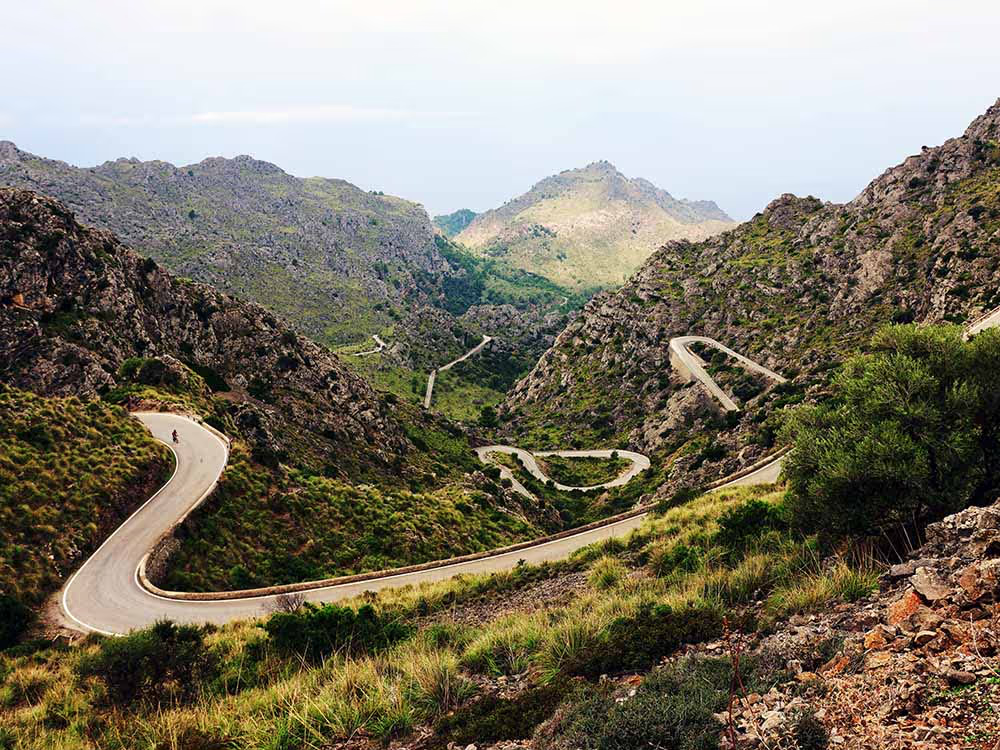Let’s face it, not everyone has mountains in their backyard. Some of us are dodging traffic lights, riding loops around city parks, or just lucky enough to get a few rolling hills in if the wind’s blowing the right way. And yet, when it comes time to head to Mallorca and face those long, steady climbs like Sa Calobra or Coll de Sóller, we still want to feel strong, not like we’re dragging a trailer full of bricks behind us.
So how do you train for the mountains when you don’t have mountains?
The good news is, you can. You just need to be smart about it, and train your body and mind for what climbing really demands. It’s not about being on a mountain, it’s about simulating the effort. And we’ve got ways to do that.
What Climbing Is Really About
Climbing isn’t just about elevation. It’s about sustained power output, efficient pacing, mental toughness, and managing your effort without blowing up. You could be living in the flatlands and still build legs that are ready to climb all day long if you focus on the right stuff.
What you need to mimic is that sustained, steady, grind. The feeling of holding threshold power or sitting just below it for ten, twenty, or even thirty minutes at a time without letting your form fall apart. If you can train that, you’ll be in a good place when the road kicks up.
Use Your Turbo or Smart Trainer Properly
If you’ve got a turbo trainer or something like a Wahoo Kickr or a Tacx setup, you’re golden. That machine is your mountain.
Set up interval sessions that replicate climbing. Think of a climb like Sa Calobra. It’s around 10 kilometres, roughly a 6 percent average, and takes most people between 35 and 50 minutes, depending on fitness and how many photos they stop to take.
So how do you simulate that at home? You train in blocks. For example:
- Two sets of 3 x 10 minutes at tempo or sweet spot effort, with 5 minutes recovery between efforts
- Gradually build up to longer blocks like 2 x 20 minutes at threshold
- Add in some low-cadence sessions. Sit at 60 to 70 RPM and push steady watts to replicate the feeling of grinding uphill. It’s hard but it works
Make sure your fan is blasting, you’ve got water and electrolytes, and you’re fuelling as if you were outside. Train how you’ll ride, right?
Strength Training for Climbers
You don’t need a full gym to build climbing strength, but some basic strength work can go a long way. Strong glutes, hamstrings, and core muscles make a massive difference when you’re grinding uphill.
Simple bodyweight stuff like:
- Bulgarian split squats
- Glute bridges
- Step-ups
- Lunges
- Planks
Do it consistently, twice a week. Keep the reps low and controlled. You don’t need to go heavy. The goal is muscle activation and resilience, not bulking up.
Hills and Wind Are Your Friends
If you’ve got short hills nearby, use them. Hill repeats are incredibly effective for building power and fatigue resistance. Find a hill that takes you two to four minutes to climb and do repeats until your legs are cooked. Ride up steady, recover on the way down, repeat.
No hills? No problem. Ride into a headwind. Seriously. A solid headwind on a flat road can feel just like a climb. Get low, stay steady, and push into it. It’ll teach you to hold power consistently and keep your form tight, just like you need to do on a climb.
Ride Steady, Ride Long
One of the biggest mistakes people make is riding too hard too often. When you’re prepping for a camp with long climbs, it’s better to build your endurance engine with long, steady rides than to chase PBs every time you ride.
Ride at a pace where you can hold a conversation. Stay in zone two. Learn how to fuel during those longer efforts, how to pace yourself, and how to ride when you’re tired. This stuff matters more in the mountains than chasing KOMs on your local loop.
Pacing and Mental Game
A big part of climbing is in your head. If you go too hard early on a long climb, you’re going to suffer. Learn to pace yourself properly. Use your heart rate or power meter if you’ve got one. If not, go by feel. Start easier than you think you need to. Let your breathing settle in. Stay in the saddle as much as possible. You’re not sprinting to the top. You’re managing effort.
Training on a turbo helps with this. You get used to holding a steady effort without interruptions. That’s exactly what you’ll need on those steady Mallorcan climbs.
Climb Simulation Rides
Here’s a simple training ride to mimic a climbing day:
- Warm up for 15 minutes
- Ride 4 x 10 minutes at sweet spot effort (just below threshold), low cadence if possible
- Recover for 5 minutes between intervals
- Add in 3 sets of 30 seconds out of the saddle efforts with 90 seconds easy spin between each
- Cool down for 15 minutes
Done right, you’ll feel like you’ve done a long climb. Do this once or twice a week and you’ll be amazed how strong your legs feel when the road tilts up.
Use Your Brain, Not Just Your Legs
Remember, this is about simulating the experience, not matching it exactly. Don’t get hung up on not having a 10k climb outside your door. What you can do is train the systems that matter — muscular endurance, aerobic capacity, fuelling habits, and mental strength.
When you arrive in Mallorca, you’ll have all the pieces in place. The scenery and the switchbacks will take care of the rest.
Want to Test Your Climbing Legs?
At VeloCamp Mallorca, we ride the real climbs. Sa Calobra, Coll de Sóller, Coll d’Honor — these are the roads we take every week. But we’re not here to race you to the top. We’re here to help you ride better, feel stronger, and enjoy the experience. No matter your level, you’ll finish the week feeling like a better cyclist.
Book your place at www.velocampmallorca.com and come see what your legs can really do.
See you on the climbs. You’ve got this.








